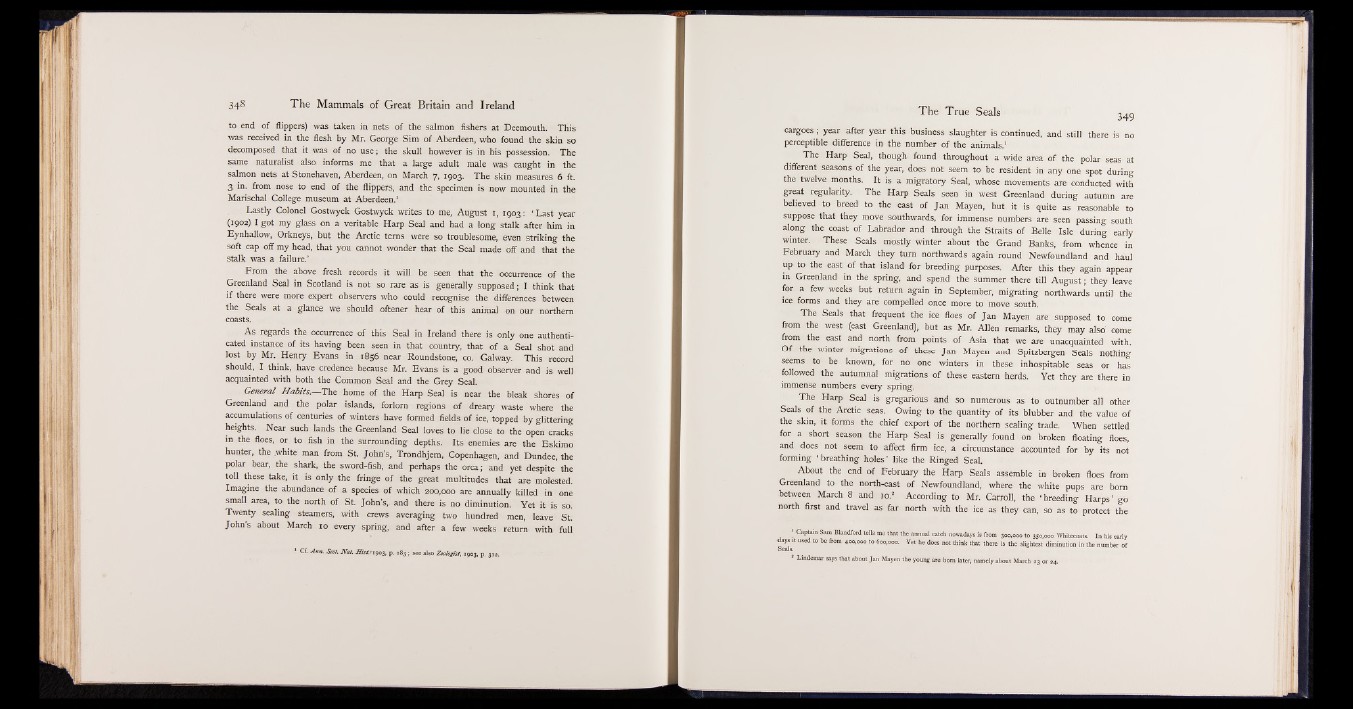
to end of flippers) was taken in nets of the salmon fishers at Deemouth. This
was received in the flesh by Mr. George Sim of Aberdeen, who found the skin so
decomposed that it was of no use; the skull however is in his possession. The
same naturalist also informs me that a large adult male was caught in the
salmon nets at Stonehaven, Aberdeen, on March 7, 1903. The skin measures 6 ft.
3 in. from nose to end of the flippers, and the specimen is now mounted in the
Marischal College museum at Aberdeen.1
Lastly Colonel Gostwyck Gostwyck writes to me, August 1, 1903: ‘ Last year
(1902) I got my glass on a veritable Harp Seal and had a long stalk after him in
Eynhallow, Orkneys, but the Arctic terns were so troublesome, even striking the
soft cap off my head, that you cannot wonder that the Seal made off and that the
stalk was a failure.’
From the above fresh records it will be seen that the occurrence of the
Greenland Seal in Scotland is not so rare as is generally supposed; I think that
if there were more expert observers who could recognise the differences between
the Seals at a glance we should oftener hear of this animal on our northern
coasts.
As regards the occurrence of this Seal in Ireland there is only one authenticated
instance of its having been seen in that country, that of a Seal shot and
lost by Mr. Henry Evans in 1856 near Roundstone, co. Galway. This record
should, I think, have credence because Mr. Evans is a good observer and is well
acquainted with both the Common Seal and the Grey Seal.
General Habits.— The home of the Harp Seal is near the bleak shores of
Greenland and the polar islands, forlorn regions of dreary waste where the
accumulations of centuries of winters have formed fields of ice, topped by glittering
heights. Near such lands the Greenland Seal loves to lie close to the open cracks
in the floes, or to fish in the surrounding depths. Its enemies are the Eskimo
hunter, the white man from St. John’s, Trondhjem, Copenhagen, and Dundee, the
polar bear, the shark, the sword-fish, and perhaps the orca; and yet despite the
toll these take, it is only the fringe of the great multitudes that are molested.
Imagine the abundance of a species of which 200,000 are annually killed in one
small area, to the north of St. John’s,, and there is no diminution. Yet it is so.
Twenty sealing steamers, with crews averaging two hundred men, leave St.
John’s about March 10 every spring, and after a few weeks return with full
1 C l Ann- Nat. Hist.11903, p. 183; see also Zoologist, 1903, p. 31a.
The True Seals
cargoes; year after year this business slaughter is continued, and still there is no
perceptible difference in the number of the animals.1
The Harp Seal, though found throughout a wide area of the polar seas at
different seasons of the year, does not seem to be resident in any one spot during
the twelve months. It is a migratory Seal, whose movements are conducted with
great regularity. The Harp Seals seen in west Greenland during autumn are
believed to breed to the east of Jan Mayen, but it is quite as reasonable to
suppose that they move southwards, for immense numbers are seen passing south
along the coast of Labrador and through the Straits of Belle Isle during early
winter. These Seals mostly winter about the Grand Banks, from whence in
February and March they turn northwards again round Newfoundland and haul
up to the east of that island for breeding purposes. After this they again appear
in Greenland in the spring, and spend the summer there till August; they leave
for a few weeks but return again in September, migrating northwards until the
ice forms and they are compelled once more to move south.
The Seals that frequent the ice floes of Jan Mayen are supposed to come
from the west (east Greenland), but as Mr. Allen remarks, they may also come
from the east and north from points of Asia that we are unacquainted with.
Of the winter migrations of these Jan Mayen and Spitzbergen Seals nothing
seems to be known, for no one winters in these inhospitable seas or has
followed the autumnal migrations of these eastern herds. Yet they are there in
immense numbers every spring.
The Harp Seal is gregarious and so numerous as to outnumber all other
Seals of the Arctic seas. Owing to the quantity of its blubber and the value of
the skin, it forms the chief export of the northern sealing trade. When settled
for a short season the Harp Seal is generally found on broken floating floes,
and does not seem to affect firm ice, a circumstance accounted for by its not
forming ‘ breathing holes ’ like the Ringed Seal.
About the end of February the Harp Seals assemble in broken floes from
Greenland to the north-east of Newfoundland, where the white pups are born
between March 8 and io.2 According to Mr. Carroll, the ‘ breeding Harps’ go
north first and travel as far north with the ice as they can, so as to protect the
1 Captain Sam Blandford tells me that the annual catch nowadays is from 300,000 to 350,000 Whitecoats. In his early
days it used to be from 400,000 to 600,000. Yet he does not think that there is the slightest diminution in the number of
2 L,ndemar says that about Jan Mayen the young are bom later, namely about March 23 or 24.